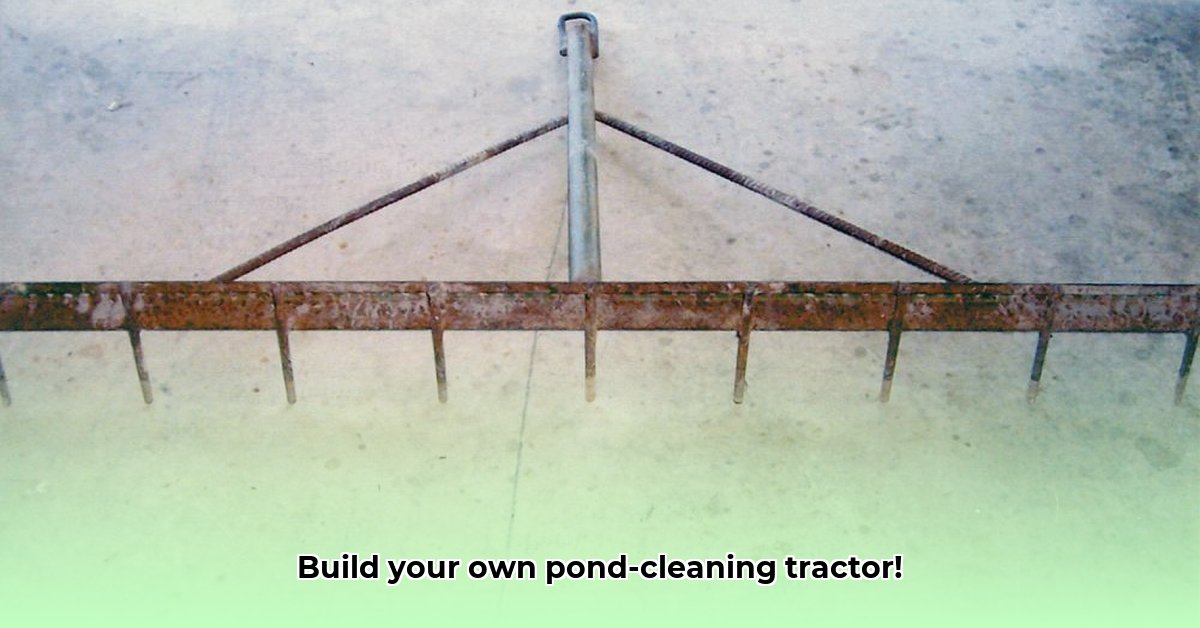
Keeping your pond clear of weeds can be a time-consuming and costly endeavor. While professional weed removal services offer efficiency, they come with a hefty price tag. This guide explores a budget-friendly alternative: building your own tractor-powered pond rake. We'll detail the construction process, compare it to other methods, and highlight crucial safety and environmental considerations. Is a DIY pond rake the right solution for you? Let's find out. For more information on tractor attachments, check out this helpful resource: tractor attachments.
Designing Your DIY Pond Rake: A Tailored Approach
Before you begin, assessing your pond is paramount. Consider its size, the type and density of weeds, and your tractor's capabilities. A small pond with sparse surface weeds requires a simpler design than a large pond choked with dense, submerged vegetation. Sketching a preliminary design helps visualize the final product and identify necessary materials. What's the best approach to balance cost-effectiveness with efficiency?
Gathering Your Supplies: Essential Materials and Tools
The materials you'll need depend on your pond's specifics and your desired level of sturdiness, but here's a general list:
- Heavy-duty steel pipes or rebar: (Strong metal rods used for the rake's frame) The thickness depends on your pond's size and weed density.
- Robust steel tines: (The "teeth" of the rake) Consider repurposing old cultivator tines for durability.
- Welding equipment (or access to a welder): Welding creates the strongest connections; strong bolts are a viable alternative.
- Bolts, nuts, and washers: Necessary for both welding and bolting construction methods.
- A tractor three-point hitch attachment: (A mechanism connecting your rake to your tractor) Ensure compatibility with your tractor model.
- Measuring tape, level, and marker: For precise measurements and construction.
- Safety glasses and gloves: Absolutely essential for personal safety.
Building Your DIY Pond Rake: A Step-by-Step Guide
This project requires mechanical skills and careful execution. Here's a detailed, step-by-step guide:
Frame Construction: Cut and weld (or bolt) the steel pipes to create a rectangular frame, the dimensions depending on your pond's size and desired rake width. Ensure a sturdy, square frame.
Tine Attachment: Securely attach the steel tines to the frame, ensuring even spacing for efficient weed removal. Adjust tine angles as needed for optimal weed grabbing.
Three-Point Hitch Integration: Carefully weld or bolt a three-point hitch bracket to the frame, ensuring perfect alignment with your tractor's hitch points. Double-check before welding or bolting.
Testing and Refinement: Before full-scale pond use, test the rake in a small area to identify and correct any alignment or stability issues. This prevents damage and ensures efficient operation.
Weighing the Pros and Cons: DIY vs. Professional Weed Removal
A DIY approach offers several advantages, but also presents limitations:
| Feature | Pros | Cons |
|---|---|---|
| Cost | Significantly cheaper than professional services or pre-made rakes. | Requires material and tool investment (potentially including welding equipment). |
| Customization | Tailorable to specific pond and weed types. | Requires mechanical skills and potentially welding expertise. |
| Efficiency | Highly efficient for larger ponds, saving significant time and effort. | May be less efficient than commercial equipment for very dense weed growth. |
| Environmental Impact | Minimizes chemical use, promoting a healthy pond ecosystem. | Risk of inadvertently harming aquatic life or disturbing pond sediment. |
Key Considerations: Safety, Sustainability, and Pond Health
- Pond Ecosystem Protection: Minimize disturbance to aquatic life and plants. Avoid excessive raking.
- Soil Disturbance Minimization: Excessive raking can increase sediment. Balance weed removal with ecosystem health.
- Weed Regrowth: Raking is most effective as part of a comprehensive weed management strategy. Weeds will often regrow.
- Safety: Always wear appropriate safety gear (eye protection, gloves). Operate the tractor carefully and follow all safety guidelines.
Actionable Intelligence: Choosing the Right Approach
"The best approach depends entirely on the size of your pond and the severity of the weed problem," says Dr. Emily Carter, Aquatic Ecologist at the University of California, Berkeley. "For small ponds with light weed growth, a DIY rake can be effective. However, larger ponds or those with extensive weed infestations may benefit from professional services or more powerful equipment."
This highlights the importance of realistic assessment before undertaking this project. A DIY pond rake is a valuable tool, but it's not a universal solution.
For sustainable weed management, consider responsible weed disposal methods. Never dump weeds back into the pond. Check local regulations for appropriate disposal options, such as composting (avoiding invasive species). Avoid harmful chemicals. A DIY rake is a cost-effective tool, but it’s most effective when part of a larger, integrated approach to pond maintenance.